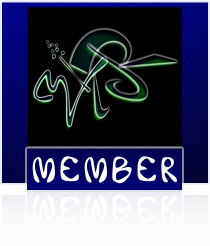1 TCP/IP အေၾကာင္းေလး 19th June 2009, 2:52 pm
TCP/IP အေၾကာင္းေလး 19th June 2009, 2:52 pm
ET
Moderator


TCP/IP အေၾကာင္းေလး ေျပာမယ္္ဗ်ာ
(၁) IP address ဆိုတာ ဘာလဲ ?
TCP/IP = Transmission Control Protocol and Internet Protocol ျဖစ္ပါတယ္ ။
IP တစ္ခု ဟာ 32 bit binary number ျဖစ္ၿပီး decimal ဂဏန္း 4 လံုးနဲ ့ေဖာ္ျပေလ ့ရွိပါတယ္ ။
decimal ဂဏန္း 1 လံုးစီဟာ 8 bits 0 to 255 (octets) ကုိကုိယ္စားျပဳပါတယ္ ။အဲလုိ ေဖာ္ျပတာကို “dotted decimal” လုိ ့ေခၚပါတယ္ ။
Example; 140.179.220.200 (Dotted decimal)
10001100.10110011.11011100.11001000 (Binary)
(၂) အမ်ိဳးအစား ဘယ္ႏွခု ရွိပါသလဲ ?
Classes အမ်ိဳးအစားကုိ အခုလို ခြဲထားပါတယ္ ။
Class Range of Address
A 1 to 126(127) binary 0xxx နဲ ့စ ပါတယ္။
B 128 to 191 binary 10xx နဲ ့စ ပါတယ္။
C 192 to 223 binary 110x နဲ ့စ ပါတယ္။
----------------------------------------------------------------------------
D 224 to 239 binary 1110 နဲ ့စ ပါတယ္။
E 240 to 254 binary 1111 နဲ ့စ ပါတယ္။
က်န္ေနတဲ့ 127(localhost) ကို local loopback အတြက္သံုးပါတယ္ ။သင္ 127.0.0.1 ကို ping ၿပီးစမ္းသပ္ႏိုင္ပါတယ္ ။
Class D addresses ကို multicasting အတြက္ သံုးပါတယ္။ Class E addresses ကုိေတာ့ future use ဆုိၿပီးသတ္မွတ္ထားပါတယ္ ။အဲဒါေၾကာင့္
သင့္ရဲ
့ IP address ကိုရိုက္တဲ့ အခါ 1 to 223 ကေနပဲ စရုိက္လို ့ရပါတယ္ ။ 224
ကေနစၿပီး ေနာက္ပုိင္းကုိ ရုိက္လုိ ့မရပါဘူး ။ အလြယ္တကူ စမ္းသပ္
ၾကည့္ႏုိင္ပါတယ္ ။
Private Network Address ၄ ခုရွိပါတယ္ ။
( Local loopback Address )- 127.0.0.1
( Class A )- 10.0.0.0
( Class B )- 172.16.0.0
( Class C )- 192.168.0.0
Class
ေတြကို ပံုမွန္အားျဖင့္ ဘယ္လုိဆံုးျဖတ္သလဲ ဆိုတာ ေလ့လာၾကရေအာင္- (N) က
network ကိုကိုယ္စားျပဳၿပီး (n) က node ကုိကိုယ္စားျပဳပါတယ္ ။
- Class A -- NNNNNNNN.nnnnnnnn.nnnnnnn.nnnnnnn
- Class B -- NNNNNNNN.NNNNNNNN.nnnnnnnn.nnnnnnnn
- Class C -- NNNNNNNN.NNNNNNNN.NNNNNNNN.nnnnnnnn
အဲဒါေၾကာင့္
Class A ကိုသံုးမယ္ဆိုရင္ network (N)ေပါင္း 2^8 = 255 ကိုသံုးႏုိင္မွာျဖစ္ၿပီး အဲဒီ network ရဲ ့ေအာက္မွာ ကြန္ပ်ဴတာေပါင္း (n)
255 x 255 x 255 =16581373 လံုးကိုတပ္ဆင္အသံုးျပဳႏုိင္မွာ ျဖစ္ပါတယ္ ။
Class
B ကိုသံုးမယ္ဆိုရင္ network (N)ေပါင္း 255 x 255 =65025
ကိုသံုးႏုိင္မွာျဖစ္ၿပီး အဲဒီ network ရဲ ့ေအာက္မွာ ကြန္ပ်ဴတာေပါင္း (n)
255 x 255 = 65025 လံုးကိုတပ္ဆင္အသံုးျပဳႏုိင္မွာ ျဖစ္ပါတယ္ ။
Class
C ကိုသံုးမယ္ဆိုရင္ network (N)ေပါင္း 255 x 255 x 255 =16581373
ကိုသံုးႏုိင္မွာျဖစ္ၿပီး အဲဒီ network ရဲ ့ေအာက္မွာ ကြန္ပ်ဴတာေပါင္း
(n)255 လံုးကိုတပ္ဆင္အသံုးျပဳႏုိင္မွာ ျဖစ္ပါတယ္ ။
(IP address မွာ
192.168. ေတြပဲ ဘာလုိ ့ျဖစ္ေနရတာလဲ လို ့မၾကာခဏ အေမးခံရပါတယ္။ကုိယ္သံုးမယ္
့ ကြန္ပ်ဴတာ အေရအတြက္(node)ဟာ ၂၅၅ လံုးကုိ မေက်ာ္ဘူး ဆိုရင္ Class C ကိုပဲ
သံုးၾကလို့ပါ။)
ေနာက္တစ္ခုကေတာ့ node မွာ decimal no: 0 နဲ ့ 255 ကိုထည့္လုိ ့မရပါဘူး။(ဥပမာ- 192.168.1.0* / 192.168.1.255* )
IP address မွာ node portion all Ones (11111111)=255 က Broadcast Address ျဖစ္ပါတယ္ ။
IP address မွာ node portion all Zeros(00000000)=0 က Network Address ျဖစ္ပါတယ္ ။
(၁) IP address ဆိုတာ ဘာလဲ ?
TCP/IP = Transmission Control Protocol and Internet Protocol ျဖစ္ပါတယ္ ။
IP တစ္ခု ဟာ 32 bit binary number ျဖစ္ၿပီး decimal ဂဏန္း 4 လံုးနဲ ့ေဖာ္ျပေလ ့ရွိပါတယ္ ။
decimal ဂဏန္း 1 လံုးစီဟာ 8 bits 0 to 255 (octets) ကုိကုိယ္စားျပဳပါတယ္ ။အဲလုိ ေဖာ္ျပတာကို “dotted decimal” လုိ ့ေခၚပါတယ္ ။
Example; 140.179.220.200 (Dotted decimal)
10001100.10110011.11011100.11001000 (Binary)
(၂) အမ်ိဳးအစား ဘယ္ႏွခု ရွိပါသလဲ ?
Classes အမ်ိဳးအစားကုိ အခုလို ခြဲထားပါတယ္ ။
Class Range of Address
A 1 to 126(127) binary 0xxx နဲ ့စ ပါတယ္။
B 128 to 191 binary 10xx နဲ ့စ ပါတယ္။
C 192 to 223 binary 110x နဲ ့စ ပါတယ္။
----------------------------------------------------------------------------
D 224 to 239 binary 1110 နဲ ့စ ပါတယ္။
E 240 to 254 binary 1111 နဲ ့စ ပါတယ္။
က်န္ေနတဲ့ 127(localhost) ကို local loopback အတြက္သံုးပါတယ္ ။သင္ 127.0.0.1 ကို ping ၿပီးစမ္းသပ္ႏိုင္ပါတယ္ ။
Class D addresses ကို multicasting အတြက္ သံုးပါတယ္။ Class E addresses ကုိေတာ့ future use ဆုိၿပီးသတ္မွတ္ထားပါတယ္ ။အဲဒါေၾကာင့္
သင့္ရဲ
့ IP address ကိုရိုက္တဲ့ အခါ 1 to 223 ကေနပဲ စရုိက္လို ့ရပါတယ္ ။ 224
ကေနစၿပီး ေနာက္ပုိင္းကုိ ရုိက္လုိ ့မရပါဘူး ။ အလြယ္တကူ စမ္းသပ္
ၾကည့္ႏုိင္ပါတယ္ ။
Private Network Address ၄ ခုရွိပါတယ္ ။
( Local loopback Address )- 127.0.0.1
( Class A )- 10.0.0.0
( Class B )- 172.16.0.0
( Class C )- 192.168.0.0
Class
ေတြကို ပံုမွန္အားျဖင့္ ဘယ္လုိဆံုးျဖတ္သလဲ ဆိုတာ ေလ့လာၾကရေအာင္- (N) က
network ကိုကိုယ္စားျပဳၿပီး (n) က node ကုိကိုယ္စားျပဳပါတယ္ ။
- Class A -- NNNNNNNN.nnnnnnnn.nnnnnnn.nnnnnnn
- Class B -- NNNNNNNN.NNNNNNNN.nnnnnnnn.nnnnnnnn
- Class C -- NNNNNNNN.NNNNNNNN.NNNNNNNN.nnnnnnnn
အဲဒါေၾကာင့္
Class A ကိုသံုးမယ္ဆိုရင္ network (N)ေပါင္း 2^8 = 255 ကိုသံုးႏုိင္မွာျဖစ္ၿပီး အဲဒီ network ရဲ ့ေအာက္မွာ ကြန္ပ်ဴတာေပါင္း (n)
255 x 255 x 255 =16581373 လံုးကိုတပ္ဆင္အသံုးျပဳႏုိင္မွာ ျဖစ္ပါတယ္ ။
Class
B ကိုသံုးမယ္ဆိုရင္ network (N)ေပါင္း 255 x 255 =65025
ကိုသံုးႏုိင္မွာျဖစ္ၿပီး အဲဒီ network ရဲ ့ေအာက္မွာ ကြန္ပ်ဴတာေပါင္း (n)
255 x 255 = 65025 လံုးကိုတပ္ဆင္အသံုးျပဳႏုိင္မွာ ျဖစ္ပါတယ္ ။
Class
C ကိုသံုးမယ္ဆိုရင္ network (N)ေပါင္း 255 x 255 x 255 =16581373
ကိုသံုးႏုိင္မွာျဖစ္ၿပီး အဲဒီ network ရဲ ့ေအာက္မွာ ကြန္ပ်ဴတာေပါင္း
(n)255 လံုးကိုတပ္ဆင္အသံုးျပဳႏုိင္မွာ ျဖစ္ပါတယ္ ။
(IP address မွာ
192.168. ေတြပဲ ဘာလုိ ့ျဖစ္ေနရတာလဲ လို ့မၾကာခဏ အေမးခံရပါတယ္။ကုိယ္သံုးမယ္
့ ကြန္ပ်ဴတာ အေရအတြက္(node)ဟာ ၂၅၅ လံုးကုိ မေက်ာ္ဘူး ဆိုရင္ Class C ကိုပဲ
သံုးၾကလို့ပါ။)
ေနာက္တစ္ခုကေတာ့ node မွာ decimal no: 0 နဲ ့ 255 ကိုထည့္လုိ ့မရပါဘူး။(ဥပမာ- 192.168.1.0* / 192.168.1.255* )
IP address မွာ node portion all Ones (11111111)=255 က Broadcast Address ျဖစ္ပါတယ္ ။
IP address မွာ node portion all Zeros(00000000)=0 က Network Address ျဖစ္ပါတယ္ ။









